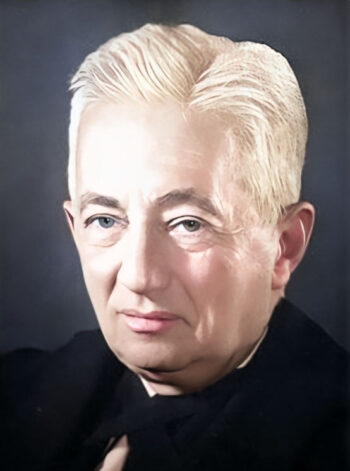van Roden, Edward L.

Edward van Roden (1892-1973) was a Pennsylvania judge who served on a special postwar committee (The Simpson Commission) to investigate possible prisoner abuse and torture by Americans against captive Germans.
Among the many war crimes of World War Two was the Malmedy Massacre of 17 December 1944. During the Battle of the Bulge, some 120 US soldiers were captured and (allegedly) executed by a Waffen-SS group. In mid-1946, and as part of the post-war Dachau Trials, U.S. prosecutors tried 74 German officers and soldiers for the murders. Eventually, 43 of them were sentenced to death by hanging.
During the trial, several defendants complained about torture and duress of various kinds. Later, about a year and a half after the trial, almost all defendants issued affidavits, complaining of abuse and rescinding their earlier confessions. As a result, U.S. Secretary of the Army Kenneth Royall created the Simpson Commission in mid-1948, which was tasked with investigating these claims. As stated, van Roden was a member of that commission. He travelled with chair Gordon Simpson to Munich in order to investigate the matter.
While there, van Roden was appalled by what he heard, both from the remaining living Germans and from the American prosecutorial team. Upon returning to the U.S., van Roden began to speak out publicly regarding his findings, eventually releasing an article titled “American atrocities in Germany” (The Progressive, Feb. 1949, pp. 21f.). The article included several shocking assertions. It opens thusly:
“American investigators at the U. S. Court in Dachau, Germany, used the following methods to obtain confessions: Beatings and brutal kickings. Knocking out teeth and breaking jaws. Mock trials. Solitary confinement. Posturing as priests. Very limited rations. Spiritual deprivation. Promises of acquittal.”
Van Roden worried that, if unpunished, these abuses “would be a blot on the American conscience for eternity,” so reprehensible were they.
At issue was the behavior of the American prosecution team. Though van Roden did not mention it, this team, like most at Nuremberg and Dachau, were heavily Jewish. The Malmedy team included Burton Ellis, Paul Shumacker, William Perl, Morris Ellowitz, Herbert Strong, and Harry Thon, along with a certain Kirschbaum, a Steiner, and a Rosenthal. The legal advisor was Col. A. H. Rosenfeld.
Van Roden elaborated on the process:
“The American prohibition of hear-say evidence had been suspended. Second and third-hand testimony was admitted, although the Judge Advocate General warned against the value of hearsay evidence, especially when it was obtained, as this was, two or three years after the act. Lt. Col. Ellis and Lt. Perl of the Prosecution pleaded that it was difficult to obtain competent evidence. Perl told the court, ‘We had a tough case to crack and we had to use persuasive methods.’ He admitted to the court that the persuasive methods included various ‘expedients, including some violence and mock trials.’ He further told the court that the cases rested on statements obtained by such methods.”
Here, Jewish prosecutors Ellis and Perl admitted that they used “persuasive methods” to obtain desired results. Van Roden continued:
“Our investigators [Ellis, Perl et al.] would put a black hood over the accused’s head and then punch him in the face with brass knuckles, kick him, and beat him with rubber hose. Many of the German defendants had teeth knocked out. Some had their jaws broken. All but two of the Germans, in the 139 cases we investigated, had been kicked in the testicles beyond repair. This was Standard Operating Procedure with American investigators. Perl admitted use of mock trials and persuasive methods including violence and said the court was free to decide the weight to be attached to evidence thus received. But it all went in.”
Those who studied the Nuremberg Military Tribunals will concur that such torture was indeed “standard operating procedure” for the Americans.
Also troubling to van Roden were the mock trials, often with a religious theme:
“Sometimes a prisoner who refused to sign was led into a dimly lit room, where a group of civilian investigators, wearing U. S. Army uniforms, were seated around a black table with a crucifix in the center and two candles burning, one on each side. ‘You will now have your American trial,’ the defendant was told. The sham court passed a sham sentence of death. Then the accused was told, ‘You will hang in a few days, as soon as the general approves this sentence; but in the meantime, sign this confession and we can get you acquitted.’ Some still wouldn’t sign. We were shocked by the crucifix being used so mockingly.
In another case, a bogus Catholic priest (actually an investigator) entered the cell of one of the defendants, heard his confession, gave him absolution, and then gave him a little friendly tip: ‘Sign whatever the investigators ask you to sign. It will get you your freedom. Even though it’s false, I can give you absolution now in advance for the lie you’d tell.’”
Such revelations by a respected American judge cast doubt on virtually all post-war confessions, including gassings of Jews, numbers killed, and alleged views of Hitler, Himmler, and other higher-ups.

You need to be a registered user, logged into your account, and your comment must comply with our Acceptable Use Policy, for your comment to get published. (Click here to log in or register.)